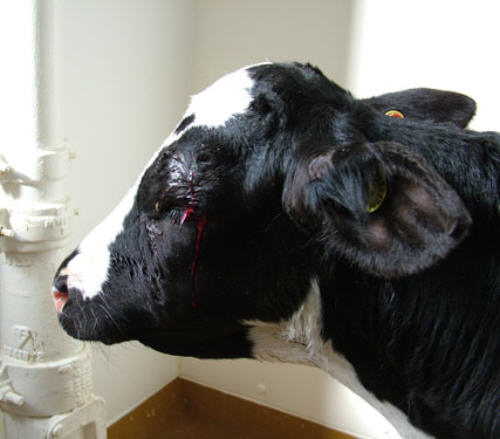



Bleeding Calf Syndrome: The Facts
Also known as idiopathic haemorrhagic diathesis of calves, or blood sweating disease, the cause of this newly identified disease is unknown. The Veterinary Laboratories Agency (VLA) is working with other organisations to investigate this disease.
The first case of in the UK was diagnosed in April, since then 77 calves on 51 farms across England and Wales have been diagnosed with the disease. Cases of the disease have also been reported in Germany, Belgium and the Netherlands, since 2008. The disease is also known in France and Italy. The Netherlands has reported more than a hundred dead calves due to the disease.

What does the disease look like?
Clinical signs in calves include bleeding from apparently intact skin and also from injection and ear tagging sites together with signs of bleeding from visible mucous membranes, nose and rectum. There may be intestinal bleeding, with calves passing dark, tarry dung. Calves are also noticed to have a high fever.
What causes the disease?
The symptoms are caused by an almost complete destruction of the bone marrow of the calf which produces the red and white blood cells vital for the animal’s immune system and blood clotting mechanisms.
This seems to be occurring at or around the time of birth, although it is uncertain whether the damage is occurring in the womb or soon after birth.
The cause is not yet known. There are a number of lines of investigation which are being pursued, which include management and environmental factors on the affected farms. Although there is currently no evidence of an infectious cause it cannot be totally ruled out at this point.
Does the disease lead to death?

Only a few calves have been affected in any one herd, but once affected they usually die. The mortality rate of calves with the disease is about 95 per cent, there are reports, mainly anecdotal, of some affected calves making a full recovery.
Only calves less than four weeks old are affected. The mothers of the affected calves are usually perfectly healthy.
Is there any risk to humans through contact or food?
As the age of the animal affected is 0 – 4 weeks, they would not be entering the food chain. The age they are affected is very consistent and the disease has never been seen in older animals.
To date no infectious agent (known or novel) likely to have caused the condition has been identified in any of the tissues of affected calves.
There has been no direct evidence or reports of any potential transmission to people in Germany where the disease has been present for at least 18 months.
There is currently no evidence to suggest that the disease is infectious or contagious.
The Human Animal Infections and Risk Surveillance (HAIRS) group, which routinely meets to assess any risks to human health from emerging diseases, has been briefed and are considering the available data.
What is being done to find out more about the disease?
Research carried out by VLA and Scottish Agricultural College (SAC), funded by Defra and the Scottish Government, is ongoing and is designed to identify the potential factors which might be causing the disease.
An international meeting is taking place in December to consider what is known about the condition and to identify the best way forward in collaborative investigation.
What should farmers do if they see the symptoms in their herd?
They should consult their own vet who can submit calves to their local VLA or SAC laboratory for a full examination. To encourage farmers to get in touch with the authorities, SAC and VLA are offering a free post mortem service to farmers who have suspected cases. Blood samples from suspected live clinical cases are carried out free of charge.


